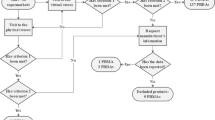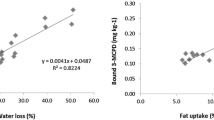Abstract
The adverse health effects of trans fatty acids (TFA) are well recognised. The Commission Regulation (EU) 2019/649 specifies that foods should not contain more than 2 g of industrially produced TFA (i-TFA) per 100 g of fat. This study aimed to investigate the fatty acid profile, with focus on TFA and i-TFA, of foods widely consumed in Greece that are purported to contain high TFA concentrations. Sweet and savoury (i.e. non-sweet), prepacked and non-prepacked (i.e. loose) processed foods (N = 140) were sampled. After lipid extraction, the fatty acid profile of each sample was determined by gas chromatography. Estimation of ruminant TFA (r-TFA) was based on butyric acid values. i-TFA was assessed after subtraction of r-TFA from total TFA. Both total and i-TFA contents of cakes, biscuits, croissants and doughnuts on average were low (< 2% of total fat), even though the saturated fat content of some products from these food groups was high. Pies and pastries made with puff and shortcrust pastry had the highest i-TFA content. About 15.7% of all samples had an i-TFA content that exceeded the 2% limit set in foods by the new Commission Regulation (EU) 2019/649. Meat products and French fries had i-TFA levels that did not exceed 1% of total fat. In view of the lack of data on TFA content of foods in Greece, these results highlight the necessity to improve their nutritional quality and provide guidance for planning future targeted inspections regarding the TFA content of foods.



Similar content being viewed by others
References
Ansorena D, Echarte A, Ollé R, Astiasarán I (2013) No trans fatty acids in Spanish bakery products. Food Chem 138:422–429
AOAC (Association of Official Analytical Chemists) (2005) Official methods of analysis, 18th edn. AOAC International, Gaithersburg
Asgary S, Nazari B, Sarrafzadegan N et al (2009) Evaluation of fatty acid content of some Iranian fast foods with emphasis on trans fatty acids. Asia Pac J Clin Nutr 18:187–192
Astiasarán I, Abella E, Gatta G, Ansorena D (2017) Margarines and fast-food french fries: low content of trans fatty acids. Nutrients 9:662
Becker W, Eriksson A, Haglund M, Wretling S (2015) Contents of total fat, fatty acids, starch, sugars and dietary fibre in Swedish market basket diets. Br J Nutr 113:1453–1465
Bendsen NT, Christensen R, Bartels EM, Astrup A (2011) Consumption of industrial and ruminant trans fatty acids and risk of coronary heart disease: a systematic review and meta-analysis of cohort studies. Eur J Clin Nutr 65:773–783
Brouwer IA, Wanders AJ, Katan MB (2013) Trans fatty acids and cardiovascular health: research completed? Eur J Clin Nutr 67:541–547
Costa N, Cruz R, Graca P, Breda J, Casal S (2016) Trans fatty acids in the Portuguese food market. Food Control 64:128–134
Dias FS, Passos ME, Tavares do Carmo MDG, Mendes Lopes ML, Valente Mesquita VL (2015) Fatty acid profile of biscuits and salty snacks consumed by Brazilian college students. Food Chem 171:351–355
EFSA Nda Panel (2010) Scientific opinion on dietary reference values for fats, including saturated fatty acids, polyunsaturated fatty acids, monounsaturated fatty acids, trans fatty acids, and cholesterol. EFSA J 8:1461–1523
European Commission (2015) Inception Impact Assessment. Initiative to limit industrial trans fats intakes in the EU. https://ec.europa.eu/smart-regulation/roadmaps/docs/2016_sante_143_trans_fats_en.pdf. Accessed 3 Jan 2020
European Commission (2018) Analytical approach for checking the compliance of fats and oils against a possible regulated limit for industrial trans fatty acids. Ref. Ares (2018)3313247—22/06/2018
Fernández-San Juan PM (2009) Trans fatty acids (tFA): sources and intake levels, biological effects and content in commercial Spanish food. Nutr Hosp 24:515–520
Foscolou A, Critselis E, Tyrovolas S, Chrysohoou C, Sidossis LS, Naumovski N, Matalas AL, Rallidis L, Polychronopoulos E, Ayuso-Mateos JL, Haro JM, Panagiotakos D (2019) The effect of exclusive olive oil consumption on successful aging: a combined analysis of the ATTICA and MEDIS epidemiological studies. Foods 8(1):E25
Fotakis Ch, Kokkotou K, Zoumpoulakis P, Zervou M (2013) NMR metabolite fingerprinting in grape derived products: an overview. Food Res Int 54:1184–1194
Girvalaki C, Vardavas CI, Tsimpinos G, Dimitreli G, Hassapidou MN, Kafatos A (2013) Nutritional and chemical quality of traditional spreads and pies of mediterranean diet of Greece. J Food Nutr Disor 2(1):1–7
Hellenic Food Authority (2015) Knowledge, attitude and behaviour of Greeks towards trans fatty acids (in Greek). https://efet.gr/files/trlip.pdf. Accessed 1 Apr 2020
Hulshof KF, van Erp-Baart MA, Anttolainen M et al (1999) Intake of fatty acids in western Europe with emphasis on trans fatty acids: the TRANSFAIR Study. Eur J Clin Nutr 53:143–157
Karabulut I (2007) Fatty acid composition of frequently consumed foods in Turkey with special emphasis on trans fatty acids. Int J Food Sci Nutr 58:619–628
Kroustallaki P, Tsimpinos G, Vardavas CI, Kafatos A (2011) Fatty acid composition of Greek margarines and their change in fatty acid content over the past decades. Int J Food Sci Nutr 62:685–691
Micha R, Mozaffarian D (2008) Trans fatty acids: effects on cardiometabolic health and implications for policy. Prostaglandins Leukot Essent Fatty Acids 79:147–152
Min DB, Steenson DF (1998) Crude fat analysis. In: Nielsen SS (ed) Food analysis, 2nd edn. Aspens Publication Inc., Gaithersburg, pp 201–215
Perez-Farinós N, Dal Re Saavedra M Á, Villalba CV, Robledo de Dios T (2016) Trans-fatty acid content of food products in Spain in 2015. Gaceta Sanitaria 30(5):379–382
Regulation (EU) No 1169/2011 of the European Parliament and of the council of 25 October 2011 on the provision of food information to consumers. In: Official Journal of the European Union
Regulation (EC) No 2019/649 of the European Parliament and of the council of 24 April 2019 as regards trans fat, other than trans fat naturally occurring in fat of animal origin. In: Official Journal of the European Union
Roe M, Pinchen H, Church S, Elahi S, Walker M, Farron-Wilson M, Buttriss J, Finglas P (2013) Trans fatty acids in a range of UK processed foods. Food Chem 140:427–431
Shahidi F (2003) Extraction and measurement of total lipids. Curr Protoc Food Anal Chem 7(1):D1.1.1–D1.1.11
Stender S, Astrup A, Dyerberg J (2016) Artificial trans fat in popular foods in 2012 and in 2014: a market basket investigation in six European countries. BMJ Open 6(3):e010673
Trattner S, Becker W, Wretling S et al (2015) Fatty acid composition of Swedish bakery products, with emphasis on trans-fatty acids. Food Chem 175:423–430
Vučić V, Arsić A, Petrović S, Milanović S, Gurinović M, Glibetić M (2015) Trans fatty acid content in Serbian margarines: urgent need for legislative changes and consumer information. Food Chem 185:437–440
World Health Organization (2019) Countdown to 2023: WHO report on global trans fat elimination Geneva, Switzerland. https://www.who.int/docs/default-source/documents/replace-transfats/report-on-tfa-elimination-2019.pdf?sfvrsn=c9378613_4. Accessed 3 Jan 2020
Author information
Authors and Affiliations
Corresponding author
Ethics declarations
Conflict of interest
The authors have no conflict of interest.
Additional information
Publisher's Note
Springer Nature remains neutral with regard to jurisdictional claims in published maps and institutional affiliations.
Rights and permissions
About this article
Cite this article
Marakis, G., Fotakis, C., Tsigarida, E. et al. Fatty acid profile of processed foods in Greece with focus on trans fatty acids. J Consum Prot Food Saf 15, 373–381 (2020). https://doi.org/10.1007/s00003-020-01290-1
Received:
Revised:
Accepted:
Published:
Issue Date:
DOI: https://doi.org/10.1007/s00003-020-01290-1




